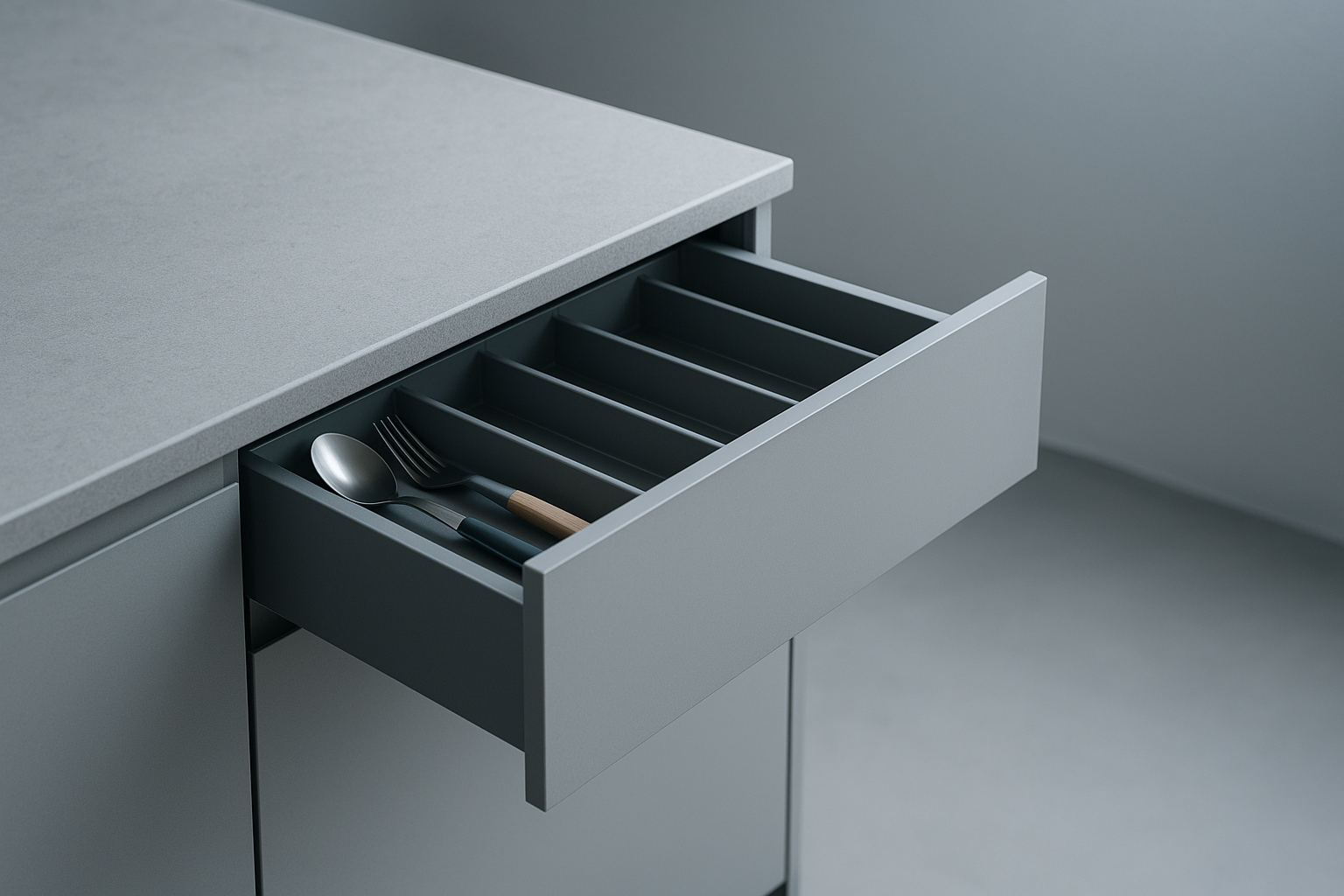Creating Smart Storage Solutions For Your Kitchen Island
Share
Copy Link

Transform your kitchen island into a powerhouse of efficiency with intelligent storage solutions. Custom drawers offer a unique opportunity to maximise space while ensuring everything you need is at your fingertips. Integrating these elements can significantly enhance both functionality and aesthetic appeal in any kitchen.
Designing a kitchen island requires careful consideration of both utility and style. Efficient storage is crucial for keeping your culinary space organised and clutter-free. By optimising your island's undercounter storage, you can create a seamless blend of form and function. Incorporating custom solutions such as specialised drawers and cabinet doors can help you achieve a cohesive look that complements your overall kitchen design. Whether you're working with an open-plan layout or a more traditional setup, these smart strategies can transform your kitchen into a well-organised haven.
Maximising undercounter storage
Custom drawers play a pivotal role in maximising the potential of your kitchen island's undercounter space. These tailored solutions allow for precise organisation, ensuring that every inch of storage is utilised effectively. By opting for bespoke drawer systems, you can tailor compartments to fit specific items, from pots and pans to utensils and small appliances. This customisation enhances accessibility and minimises clutter, allowing for a streamlined cooking experience.
The flexibility offered by custom drawers means you can adapt the storage configuration according to your needs. Adjustable dividers, pull-out shelves, and deep-set drawers can accommodate a variety of items, making it easier to keep your kitchen tidy. Additionally, these features contribute to maintaining a clean and organised workspace, which is essential for efficient meal preparation. Investing in high-quality materials ensures durability and longevity, adding value to your kitchen renovation project.
Incorporating technology into your storage solutions further enhances their functionality. Soft-close mechanisms prevent slamming, reducing wear and tear on the cabinetry over time. Consider integrating hidden charging stations within the drawers for added convenience, keeping your devices powered without compromising counter space. These thoughtful additions ensure that your kitchen remains both modern and practical, catering to the demands of contemporary living.
When planning your undercounter storage, consider implementing a zone-based organisation system. Create dedicated areas for cooking equipment, baking supplies, and food storage to streamline your workflow. Multi-tiered drawer systems can maximise vertical space, while corner solutions like lazy Susans ensure no space goes to waste. Installing LED strip lighting inside drawers adds both functionality and sophistication, making it easier to locate items in deeper storage compartments.
Smart organisation systems can further enhance the functionality of your undercounter storage. Consider implementing drawer-within-drawer configurations that maximise vertical space while keeping smaller items easily accessible. These innovative solutions can include specialised compartments for cutlery, cooking utensils, and even spice storage. By incorporating adjustable dividers and modular organisers, you can adapt the storage space as your needs change over time, ensuring your kitchen island remains functional and efficient throughout its lifetime.
Ergonomic considerations should play a key role in your storage design strategy. Position frequently used items at easily accessible heights to minimise strain and improve workflow efficiency. Deep drawers can be equipped with secondary sliding levels, allowing you to store heavier items like cast iron cookware at a more manageable height. Consider installing pull-out steps or drawer-mounted risers to make upper storage areas more accessible, particularly in households where users may have different height requirements or mobility considerations.
Coordinating design elements
Ensuring a cohesive design involves seamlessly integrating various elements within your kitchen island. This coordination is crucial for achieving a unified aesthetic that ties the entire kitchen together. Selecting finishes and materials that complement the style of your drawers can significantly enhance the visual appeal of your space. It's important to choose options that reflect your personal taste while also blending harmoniously with existing elements in the room.
The placement of design elements within the kitchen island plays a critical role in defining its overall look. Thoughtful positioning ensures that every component works together cohesively, creating an inviting environment that's both functional and stylish. By opting for complementary hardware such as handles and knobs, you can further unify the design theme throughout the kitchen, enhancing its visual impact.
When coordinating design elements, consider incorporating glass fronts or open shelving to add depth and dimension to your island. These features allow you to showcase decorative items or frequently used cookware while maintaining easy access. Such elements provide an opportunity to personalise your space, adding character and charm without sacrificing practicality.
Colour psychology plays a significant role in creating a harmonious kitchen environment. Consider incorporating accent colours through drawer liners or interior finishes that complement your overall kitchen palette. These subtle details can create a sense of luxury and thoughtful design when drawers are opened. Additionally, using consistent textures and patterns across different storage elements helps maintain visual continuity throughout the space, even in areas that aren't immediately visible.
Design tips for different kitchen layouts
A polished appearance in both open-plan and traditional kitchens hinges on strategic design choices that enhance functionality while preserving aesthetics. In open-plan settings, it's essential to maintain visual continuity between the kitchen island and surrounding areas. This can be achieved by selecting materials and finishes that complement adjacent spaces, ensuring a smooth transition between different zones within the home.
For traditional kitchens, incorporating classic design elements such as crown molding or panelled cabinetry can add a touch of elegance and sophistication. These timeless features create a warm and inviting atmosphere while providing ample storage options for everyday essentials. Opting for neutral colour palettes or wood tones further enhances the classic appeal, making it easy to update accessories or décor items over time.
Lighting plays an integral role in defining the ambiance of any kitchen space. Installing pendant lights above the island adds both style and functionality, providing focused illumination for meal prep or entertaining guests. Dimmable lighting options offer versatility, allowing you to adjust brightness levels according to different activities throughout the day.
When designing storage solutions for irregularly shaped kitchen islands, custom corner units and angled drawers can transform potentially wasted spaces into functional storage areas. Consider incorporating pull-out corner systems that provide full access to deep cabinet spaces, or diagonal drawer configurations that maximise unusual angles. These specialised solutions ensure that every inch of your kitchen island contributes to its overall functionality, regardless of its shape or size.
Choosing the right materials
The selection of materials is fundamental in ensuring both durability and aesthetic appeal in kitchen islands. High-quality woods such as oak or maple offer timeless beauty while standing up to daily wear and tear. For those seeking more contemporary options, engineered materials like MDF provide sleek finishes at competitive price points without compromising strength or resilience.
Your choice of finish impacts not only appearance but also maintenance requirements over time. Durable laminates or painted finishes offer low-maintenance solutions ideal for busy households seeking practicality alongside style appeal. Conversely, natural stone countertops lend luxury yet require periodic sealing treatments safeguarding against stains from spills common during cooking activities.
Sustainability considerations should influence material selections whenever possible; opting for eco-friendly products aligns environmental values with modern design trends supporting responsible consumerism practices within home renovation contexts today. This approach not only benefits the environment but also enhances the long-term value of your kitchen renovation project.
The integration of antimicrobial materials and easy-clean surfaces has become increasingly important in modern kitchen design. Consider materials treated with antimicrobial properties for drawer interiors and handling surfaces, particularly in areas where food storage is planned. Water-resistant composites and sealed woods offer excellent protection against moisture damage, while newer hybrid materials combine the aesthetics of natural materials with the durability of synthetic options, providing the best of both worlds for busy kitchen environments.



